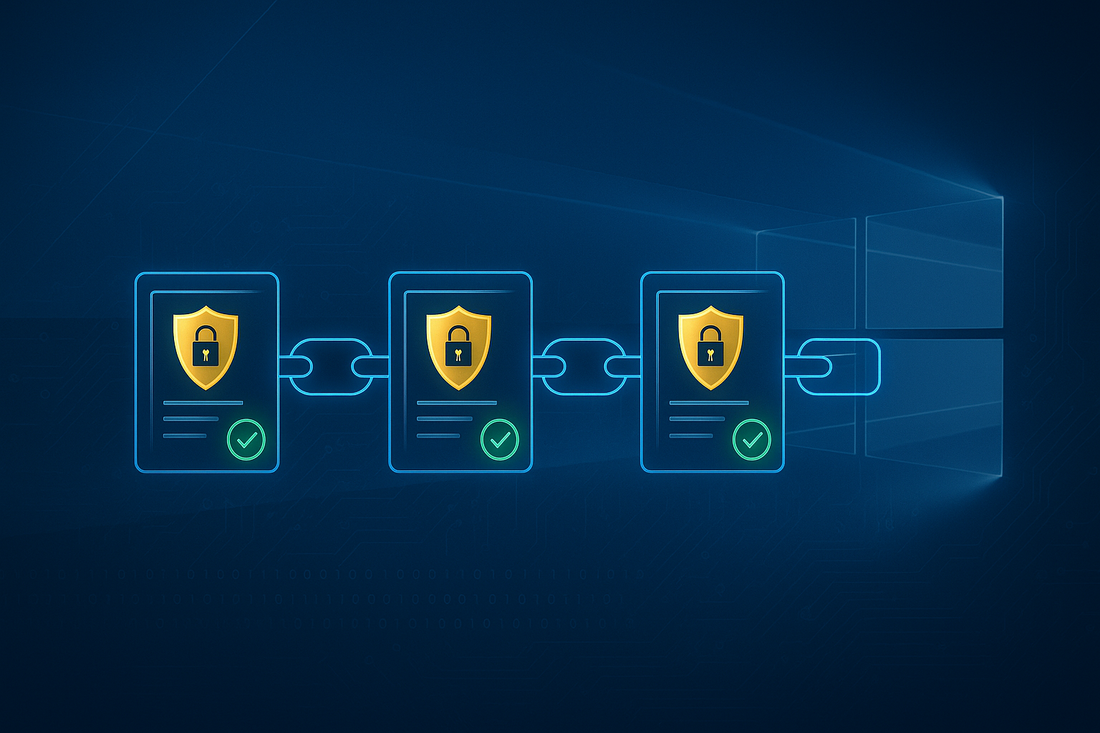
Windows IIS SSL Certificate Chain Issues : Why Your Server Chooses the Wrong Path
Zane LucasShare
Windows IIS servers exhibit a unique SSL Certificate chain-building behavior that creates significant compatibility challenges across the industry.
Unlike other web servers that prioritize maximum compatibility, Windows IIS automatically constructs the shortest possible SSL Certificate chain when multiple valid paths exist.
This optimization, while efficient for client machines, causes widespread issues for servers that need to support diverse clients ranging from modern browsers to legacy systems and IoT devices.
The problem stems from a fundamental design decision in Windows SSL Certificate handling.
When presented with multiple valid chains to trusted roots, Windows selects the path with the fewest intermediate SSL Certificates, regardless of which chain offers broader compatibility.
This behavior particularly affects organizations using SSL Certificates with cross-signing arrangements, where newer roots are cross-signed by older, more established Certificate Authorities (CAs) to maintain backward compatibility.
Understanding Why Chain Length Matters
Server SSL Certificate chains require different optimization priorities than client systems. While clients benefit from shorter chains that reduce validation time and overhead, servers must prioritize universal accessibility.
Longer SSL Certificate chains typically include cross-signatures from well-established Certificate Authorities (CAs) that have been embedded in trust stores for decades, ensuring compatibility with older browsers, mobile devices, and embedded systems that rarely receive updates.
The compatibility gap becomes critical when serving SSL Certificates to international audiences or specialized environments.
Legacy Android devices, enterprise systems with controlled update cycles, and various IoT devices may not recognize newer root SSL Certificates.
When Windows IIS sends a shorter chain terminating at a newer root, these clients fail to establish secure connections, resulting in access failures and security warnings that damage user experience and trust.
The Sectigo® SSL Certificate Chain Issue
As one of the world's largest Certificate Authorities (CAs) and the primary SSL Certificate provider for Trustico®, Sectigo® maintains two distinct chains for their Public Server Authentication Root R46.
The self-signed version creates a shorter, direct chain that Windows prefers. The alternative uses the same R46 SSL Certificate cross-signed by USERTrust RSA Certification Authority, creating a longer chain with superior compatibility.
This dual-chain arrangement exists because USERTrust RSA Certification Authority has been trusted since 2000, achieving near-universal presence in trust stores worldwide.
The newer Sectigo® root, while recognized by modern systems, lacks this historical presence. Windows IIS invariably selects the shorter chain, causing connection failures for clients that don't recognize the newer Sectigo® root SSL Certificate.
The impact extends beyond simple compatibility issues. Organizations using Sectigo® SSL Certificates on Windows IIS servers report problems with Android devices running versions before 7.1.1, older Java applications, and various embedded systems.
These failures often emerge suddenly after SSL Certificate renewals or Windows updates, when the system rediscovers both chain options and reverts to its default shortest-path preference.
Implementing the Sectigo® Chain Fix
Resolving the Sectigo® SSL Certificate chain issue requires deliberately preventing Windows from selecting the shorter chain.
The solution involves removing the self-signed Sectigo® Public Server Authentication Root R46 from both the Root and Intermediate certificate stores where Windows normally searches during chain construction.
However, simple removal isn't sufficient, as other services might depend on this SSL Certificate. Instead, administrators must add the self-signed R46 SSL Certificate to the Untrusted Certificates list.
This configuration creates an explicit block that prevents Windows from using the shorter chain while maintaining the SSL Certificate in the system. When IIS attempts to build a chain, it encounters the untrusted SSL Certificate and automatically falls back to the cross-signed path through USERTrust RSA Certification Authority.
This approach forces all Sectigo® SSL Certificates on the server to use the longer, more compatible chain. The change affects all SSL/TLS services on the Windows server, not just IIS, requiring thorough testing of all SSL Certificate-dependent applications after implementation.
Most administrators find this improves compatibility across all services, though careful verification remains essential.
Let's Encrypt ISRG Root Transition Challenges
Let's Encrypt faced similar Windows IIS chain-building issues during their transition from DST Root CA X3 to ISRG Root X1.
Their SSL Certificates could chain to either the newer ISRG Root X1 self-signed root or the same root cross-signed by DST Root CA X3. The DST Root provided extensive compatibility through its presence in trust stores since 2000, while ISRG Root X1 only achieved widespread adoption after 2016.
When DST Root CA X3 expired in September 2021, Let's Encrypt implemented an unusual strategy by continuing to serve chains through the expired root specifically for older Android compatibility.
Windows IIS servers, however, would automatically select the shorter chain to ISRG Root X1, breaking compatibility with millions of devices worldwide. Organizations discovered this issue when Android users suddenly couldn't access their sites, requiring emergency reconfiguration of SSL Certificate stores.
The Let's Encrypt scenario demonstrated how Windows IIS behavior conflicts with real-world compatibility requirements.
While the shorter chain to ISRG Root X1 was technically correct and more efficient, it ignored the practical need to support older devices that formed significant portions of global internet traffic.
Administrators had to manually intervene to maintain service availability during this critical transition period.
DigiCert and the Symantec Acquisition Complexity
DigiCert acquisition of Symantec SSL Certificate business created one of the most complex chain-building scenarios in recent history.
During the transition, SSL Certificates might chain to legacy Symantec roots, newer DigiCert roots, or various intermediate combinations with different cross-signing arrangements.
The situation intensified when Google Chrome began distrusting Symantec-issued SSL Certificates, requiring careful migration strategies that Windows IIS chain selection often disrupted.
Extended Validation SSL Certificates faced particular challenges during this transition. Maintaining the correct chain was crucial for displaying organization verification in browsers, but Windows IIS would often select chains that, while valid, didn't preserve the EV indicators.
Organizations investing in EV SSL Certificates for enhanced trust suddenly found their verification badges disappearing due to chain selection issues.
The DigiCert-Symantec situation revealed how corporate consolidation in the Certificate Authority (CA) industry creates lasting technical challenges.
Years after the acquisition, administrators managing legacy systems must still understand the historical context and manually configure chains to ensure proper SSL Certificate validation and trust indicators.
GlobalSign Geographic Compatibility Considerations
GlobalSign SSL Certificates demonstrate how geographic factors compound Windows IIS chain issues.
Their R3 and R6 roots have different adoption rates across regions, with newer roots offering enhanced security but lacking presence in trust stores throughout developing markets. Windows IIS selection of shorter chains can inadvertently block access for significant portions of international traffic where older devices remain prevalent.
Different regions exhibit varying browser preferences, operating system distributions, and update frequencies. An SSL Certificate chain that works perfectly for North American and European users might fail for substantial portions of Asian, African, or South American traffic.
GlobalSign SSL Certificates on Windows IIS require careful configuration to ensure truly global accessibility, particularly for organizations serving emerging markets.
The GlobalSign scenario also highlights the balance between security advancement and compatibility maintenance.
Their newer roots implement stronger cryptographic standards and longer key lengths, representing important security improvements.
However, these benefits become meaningless if clients can't establish connections due to Windows IIS selecting incompatible chains.
Entrust Multi-Root Management Strategies
Entrust has employed multiple root SSL Certificates throughout their history, maintaining various cross-signing arrangements for backward compatibility.
Their evolution from older 2048-bit roots to newer 4096-bit roots, combined with changing validation procedures, created multiple valid paths for SSL Certificates. Windows IIS consistently selects chains prioritizing efficiency over the compatibility that enterprise environments require.
Organizations in regulated industries face particular challenges with Entrust SSL Certificates on Windows IIS. Healthcare providers requiring HIPAA compliance or financial institutions meeting PCI DSS standards often need specific SSL Certificate chains to satisfy audit requirements.
The default Windows chain selection rarely aligns with these compliance needs, requiring manual configuration to meet regulatory obligations.
Entrust SSL Certificates also demonstrate how Certificate Authority (CA) infrastructure evolves to address emerging threats.
Each generation of roots reflects contemporary security standards, but the need to support older systems creates complex webs of cross-signatures that don't align with Windows chain-building logic, requiring ongoing administrative attention.
Common Patterns and Solution Approaches
Examining these Certificate Authority (CA) challenges reveals consistent patterns across the industry.
Issues typically emerge during transition periods when CAs migrate to newer roots, after mergers and acquisitions consolidate the industry, or when implementing enhanced security standards.
The Windows IIS behavior remains constant : selecting the shortest available chain regardless of compatibility implications.
The solution methodology remains similar regardless of the Certificate Authority (CA) involved.
Administrators must first identify multiple chain options using SSL Certificate testing tools, then determine which chain provides optimal compatibility for their user base. Finally, they configure Windows certificate stores to prevent selection of incompatible chains, often by marking certain roots as untrusted to force longer, more compatible paths.
Success requires understanding both the technical aspects of SSL Certificate chains and the practical requirements of diverse client ecosystems.
Organizations must balance security, performance, and compatibility while navigating the quirks of Windows SSL Certificate handling. This often means accepting longer chains with additional validation overhead to ensure universal accessibility.
Practical Implementation for Windows Administrators
Resolving chain-building issues begins with comprehensive inventory of all SSL Certificates deployed on Windows IIS servers.
Document which Certificate Authority (CA) issued each SSL Certificate, identify known chain issues with those authorities, and establish baseline chain configurations. This inventory becomes crucial when planning SSL Certificate renewals, especially when considering migration between Certificate Authorities (CAs).
Testing tools provide essential visibility into SSL Certificate chain behavior. Online SSL Certificate checkers display complete chains being served, while command-line tools offer detailed analysis of certificate paths.
Regular testing should become standard procedure, particularly after Windows updates or SSL Certificate renewals that might alter chain selection.
openssl s_client -connect yourdomain.com:443 -showcerts
This command reveals the complete SSL Certificate chain your IIS server delivers to clients, enabling verification against expected chains for your Certificate Authority (CA). Discrepancies between expected and actual chains indicate configuration issues requiring attention.
Windows Certificate Manager (certmgr.msc) provides the interface for managing certificate stores, but changes affect all services on the server.
Monitoring and Maintenance Best Practices
Establishing comprehensive monitoring for SSL Certificate chains prevents unexpected outages and compatibility issues. Automated systems should verify not just SSL Certificate expiration dates but also confirm correct chain delivery.
Chain modifications might occur after Windows updates, SSL Certificate renewals, or system configuration changes, making continuous monitoring essential.
Implement alerting mechanisms that notify administrators when SSL Certificate chains change unexpectedly. These alerts provide early warning before users encounter problems.
While many monitoring platforms track SSL Certificate chains, custom scripts using OpenSSL or PowerShell might be necessary for specific organizational requirements.
Schedule quarterly audits of all SSL Certificate deployments to verify chains remain appropriate for your user base.
Pay particular attention after major Windows updates, as Microsoft occasionally modifies SSL Certificate handling behavior in ways that affect chain building.
These regular reviews help maintain optimal compatibility while identifying potential issues before they impact users.
Troubleshooting SSL Certificate Chain Issues
When users report SSL Certificate errors, systematic troubleshooting helps identify whether chain building causes the problem. Start by determining which clients experience issues. Problems affecting only older devices or specific platforms strongly indicate chain compatibility issues rather than general SSL Certificate problems.
Error messages provide valuable diagnostic information about chain problems. Messages referencing untrusted roots or inability to verify the Certificate Authority (CA) typically indicate chain issues.
Generic SSL Certificate errors might have multiple causes, requiring deeper investigation. Collect specific error messages, affected client details, and timing information to guide troubleshooting efforts.
Testing from multiple platforms helps isolate chain-specific issues. Use online SSL Certificate testing tools that simulate various clients, or maintain test devices running different operating system versions.
This testing reveals which clients successfully validate your SSL Certificate chain and which encounter problems, guiding configuration adjustments.
Security Considerations in Chain Management
While focusing on compatibility, administrators must not compromise security when managing SSL Certificate chains. Moving SSL Certificates to untrusted stores or manipulating chain building might create unexpected vulnerabilities.
Always evaluate security implications before implementing chain management strategies, ensuring compatibility improvements don't weaken security posture.
Regular security audits should include SSL Certificate chain verification to ensure modifications haven't inadvertently created vulnerabilities.
Document security considerations for each chain management decision, demonstrating due diligence for compliance audits. Consider implementing SSL Certificate pinning for critical applications where appropriate, though balance security benefits against operational complexity.
Remember that chain management affects all SSL/TLS services on the server, not just web traffic. Database connections, API integrations, and internal services might use the same SSL Certificate stores.
Comprehensive testing across all services ensures chain modifications don't disrupt critical business functions while improving web server compatibility.
Recommendations
Windows IIS SSL Certificate chain issues represent a fundamental challenge requiring ongoing attention from administrators.
The platform's preference for efficiency over compatibility creates management overhead that can't be eliminated, only managed through careful configuration and monitoring.
Understanding how different Certificate Authorities (CAs) are affected enables organizations to maintain reliable, secure services accessible to all users.
For organizations using Sectigo® SSL Certificates through Trustico®, the chain management solution is well-documented and proven effective. By preventing Windows from selecting the shorter chain through strategic use of the Untrusted Certificates store, administrators ensure maximum compatibility while maintaining security. This approach, combined with regular monitoring and testing, provides stable SSL Certificate services across diverse client platforms.
Contact Trustico® today to learn how our Sectigo® SSL Certificate solutions and expert guidance can simplify your SSL Certificate management while ensuring optimal compatibility for all your users.



